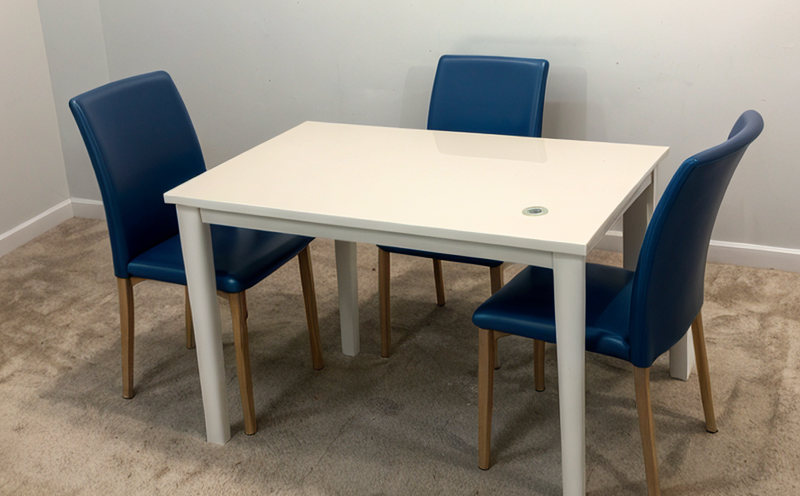ASTM D5116 Indoor Air Emission Testing of Furniture Plastics
The ASTM D5116 test method is a crucial procedure for evaluating the indoor air emissions from furniture plastics. This testing ensures that the materials used in furniture do not release harmful volatile organic compounds (VOCs) or other air pollutants into the environment, which could pose health risks to consumers.
Furniture manufacturers are increasingly concerned with improving product quality and safety, especially as regulations become more stringent across various jurisdictions like California, Europe, and China. The ASTM D5116 test is designed to simulate real-world conditions in a controlled environment. This helps manufacturers ensure compliance with local and international standards while maintaining the integrity of their products.
The testing process involves placing samples inside a chamber under specific environmental conditions, allowing them to off-gas or emit volatile compounds into the enclosed space. Sensors monitor these emissions over time, providing detailed data on both short-term and long-term exposure levels.
Understanding the significance of this test is essential for quality managers, compliance officers, R&D engineers, and procurement teams involved in developing furniture products that meet stringent emission standards. By leveraging ASTM D5116 testing, companies can reduce risks associated with non-compliance while enhancing brand reputation through responsible manufacturing practices.
Here are some key points to consider when preparing for ASTM D5116 testing:
- Select appropriate test specimens that represent the materials used in your product line.
- Ensure proper setup of the emission chamber according to standard specifications.
- Monitor temperature, humidity, and airflow during the testing period.
- Analyze results thoroughly to identify potential areas for improvement or optimization.
The primary goal of ASTM D5116 is not only to protect consumer health but also to foster innovation within the industry. By adhering to this standard, furniture manufacturers can stay ahead of regulatory changes and market trends, ultimately leading to safer products.
| Parameter | Description |
|---|---|
| Emission Chamber Volume | 3.0 cubic feet (approximately 0.084 m³) |
| Testing Duration | 96 hours minimum for short-term exposure; up to 168 hours for long-term exposure |
| Initial Chamber Conditions | 23°C ± 2°C and 50% relative humidity ± 5% |
| Sampling Rate | Every hour during the first 48 hours, then every two hours until completion |
Understanding these parameters is crucial for accurate testing results. At Eurolab, we pride ourselves on providing precise and reliable data to our clients.
Scope and Methodology
The scope of ASTM D5116 indoor air emission testing encompasses the evaluation of volatile organic compounds (VOCs) released by furniture plastics during use. This includes identifying which specific types of VOCs are present in emissions, their concentrations, and how they compare against acceptable limits set forth by relevant standards.
The methodology involves placing samples inside a controlled environment where they are exposed to specific conditions that mimic actual usage scenarios. During this exposure period, the emission chamber captures and analyzes any released compounds using sophisticated analytical instruments such as gas chromatography-mass spectrometry (GC-MS).
Here’s an overview of the key steps involved:
- Select representative samples from your product line.
- Cleanse the emission chamber thoroughly before introducing new samples.
- Place selected samples into the chamber and maintain specified temperature, humidity levels, and airflow rates.
- Allow emissions to develop over a predetermined period (typically 96 hours).
- Use sampling devices to collect air samples periodically throughout the testing interval.
- Analyze collected samples using appropriate analytical techniques like GC-MS to identify and quantify emitted VOCs.
- Compare findings against established thresholds for acceptable levels of emissions.
This comprehensive approach ensures accurate measurement and interpretation of emission data, helping manufacturers make informed decisions about material selection and process optimization.
Eurolab Advantages
At Eurolab, we understand the importance of precise and reliable testing when it comes to meeting stringent indoor air quality requirements. Our state-of-the-art facilities offer several advantages that set us apart:
- Precision Instruments: We utilize advanced equipment such as GC-MS systems capable of detecting trace amounts of VOCs.
- Experienced Staff: Our team comprises highly skilled chemists and engineers who possess extensive experience in conducting ASTM D5116 tests.
- Comprehensive Reporting: We provide detailed reports that include raw data, analysis results, and recommendations for improvement based on our findings.
- Regulatory Knowledge: Our experts stay updated with the latest developments regarding indoor air quality regulations globally.
These factors contribute to our ability to deliver accurate test results consistently. Partnering with Eurolab ensures that you receive high-quality service tailored specifically to your needs.
Quality and Reliability Assurance
To maintain the highest standards of quality and reliability, Eurolab implements rigorous procedures throughout all stages of the ASTM D5116 testing process. These measures include:
- Regular Calibration: All analytical instruments used in our lab are regularly calibrated to ensure accuracy.
- Data Verification: Multiple checks are performed on collected data before finalizing reports to catch any discrepancies early on.
- Training Programs: Continuous training programs for our staff members keep them abreast of evolving methodologies and best practices.
- Quality Controls: Internal audits and external reviews help us maintain consistent quality standards across all projects.
By adhering to these stringent protocols, we can guarantee that every test conducted meets the highest industry expectations. This commitment to excellence is reflected in our consistently accurate results and satisfied customer base.





